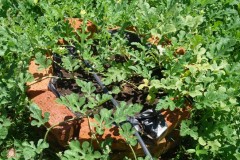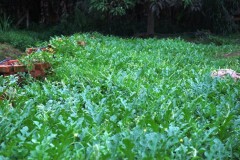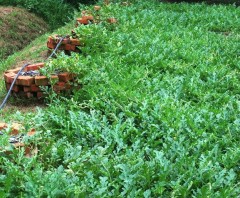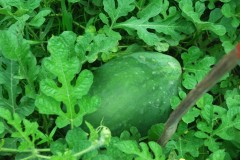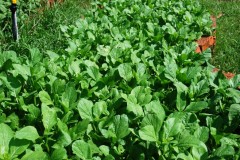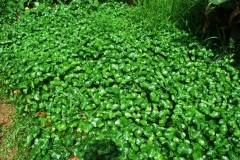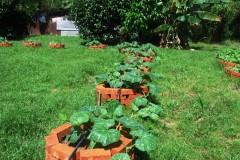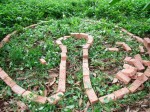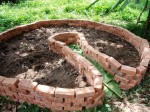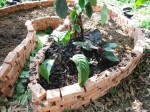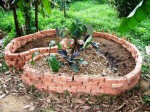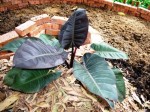Apr 30, 2010
Watermelon on Raised Beds
People don't grow watermelons on raised beds. That's what they told us.
Right, and that's why, we supposed, conventionally grown local watermelon have such a bad reputation for pesticides and fungicides!
It's logical, our climate is humid and wet, not really ideal for watermelon.
Further, local weeds will overwhelm the watermelon plant in days. So if we plant them on the ground then its logical that pests, fungal diseases and weeds must be kept at bay using a cocktail of chemicals - 3 in one!! :)
This is the raised bed we used:
Four bricks high, layer of compost at the bottom and filled to the brim with sand.
If you are planning to grow on a larger scale, do not use bricks, they are not really practical. Recycle discarded tires - just stack up two.
Lush watermelon plants fed farm-made compost tea once a week.
Heavy, succulent fruits on the way.
Things will go wrong, just don't throw out the baby with the bath water.
There are many possible reasons why the watermelon plant may not do well. Try to investigate, keep records, and modify and adapt.
One of the most common reasons is wrong seed. You will be surprised how often this mistake is made. Seeds from Japan, Taiwan, etc are not suited for growing naturally in our climate though they may thrive doing so in their home countries. We need to duplicate the conditions back home but that's not a route that sustainable farming should take.
11:05 Posted in Permaculture | Permalink | Comments (0) | Tags: raised beds, key hole garden, permaculture, watermelon
Dec 10, 2009
Raised Beds - It is Cost Effective!
Raised beds incorporating design to maximise planting areas and reducing energy input was developed by the Permaculture movement. At DQ, we have added a small innovation, i.e. to make it expandable.
The expandable raised beds are now producing their third harvest:
This is bayam pasir again. We rotated the bed used.
And this is sawi bunga, a brassica chinensis var. It will be ready for harvesting cum thinning in a few days time when the flowers emerge.
There has been no purchased input and minimal on-farm produced inputs. When we replanted, we just top up with some compost, seed the beds and add mulch. We of course rotated beds. Once a week we spray some herbal extracts and our Teh Qi (compost tea) spray. That's about it. No weeding at all was necessary.
If you click on the pictures for a close-up, you can see minimal insect damage. And the plants are sweet and aromatic.
The office staff and their children came to help themselves to the vegetables and herbs, and to have a picnic at the farm.
The next bed that we will expand to, will be used to plant a herb, most probably basil as companion plant. In this way, we will reduce even further insect problems.
Here are some pictures of raised beds elsewhere in the farm:
Lush gotu kola or pegaga raised bed.
Healthy pumpkin plants under the mid-day sun on raised beds.
Watermelon plants on raised beds.
11:11 Posted in Permaculture | Permalink | Comments (0) | Tags: raised beds, key hole garden, permaculture, dark colored plants
Aug 21, 2009
A Spot Of Darkness
I have this thing about Darkness. So we decided to build a spot of darkness in a corner of the farm; a spot dedicated to dark colored plants. Plants with dark leaves, dark flowers, dark tubers.
The plants will be grown in a raised bed with a Permaculture key-hole design.
Lay out the design with the key-hole (used for walking when tending the garden)
Build up the wall; how high depends on how deep-rooted the plants are. (These are left-over clay bricks from the walit house).

Put in the planting material; here, dead leaves, some very old broken down chicken manure, some soil etc.
Then add in the compost and the plants.
Then mulch it.
Here we have only completed planting just one corner while we hunt for more dark plants. We planted some aroids from the jungle, such as this (haven't got the name yet. Click for close-up). :
And a Tacca Chantrieri from the jungle, which flower is black (Click on photo for close-up) :
Photo of the Tacca flower from here
Once the garden is matured, perhaps we can sip dark pu erh tea and savour it with a melancholic Stratovarius playing in the background.
12:04 Posted in Blog | Permalink | Comments (0) | Tags: raised beds, key hole garden, permaculture, dark colored plants.








